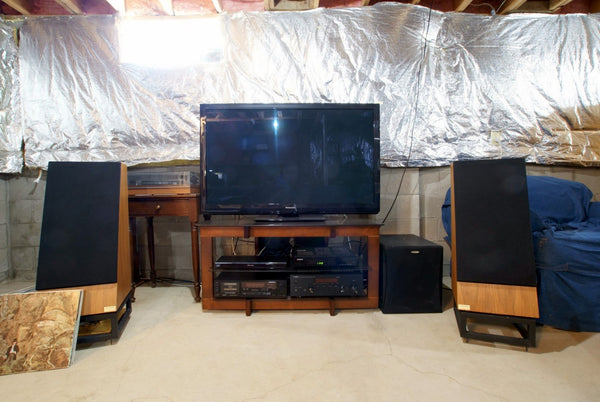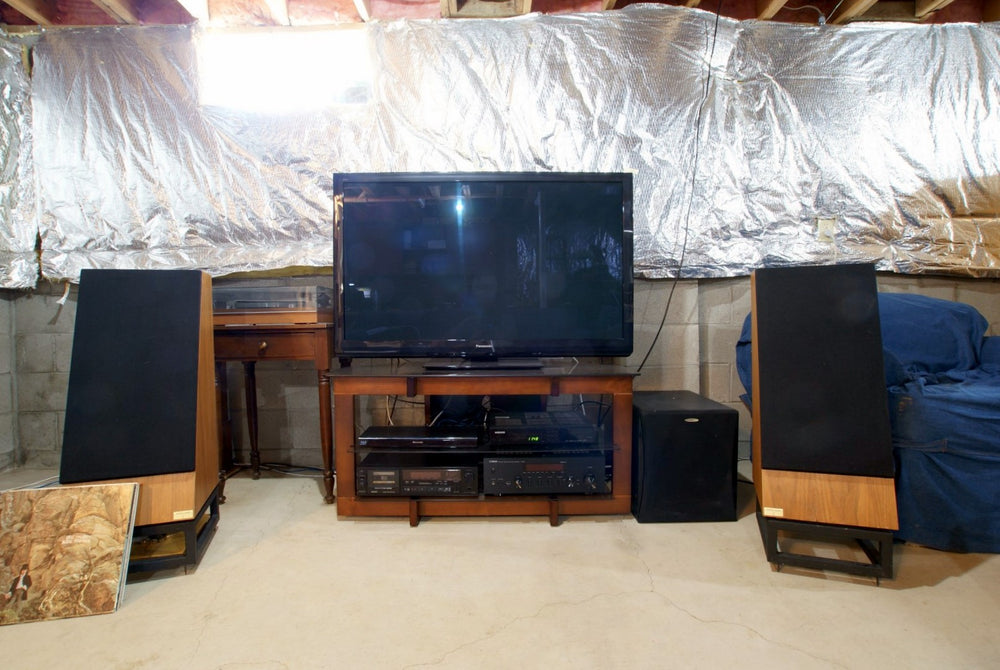Continuing with our questions & answers series, I have two that have always caused some contention. In that respect, I hope you find them interesting:
Why you should be sour on a “wide sweet spot” for serious listening with two-channel playback
Hey, we might as well get this topic kicked off with a bang…
A “wide sweet spot” is almost like having your own harmonic distortion generator! With stereo sound, there’s simply no way a serious listener should be satisfied to sit more than a foot away from the “equal path length intersection” (center point) of sound from a pair of loudspeakers. Inter-channel phase and timing information will have been badly compromised, destroying instrumental timbres.
How is it that many audiophiles will accept only phase and time-aligned loudspeakers and then they expect to sit off the acoustic center point, totally destroying the inter-channel phase/time information?
Look at it this way…
First, since you probably know this stuff, please forgive the simplified averaged wavelengths, but for purposes of illustration, let’s assume that an 1100 Hz tone (or harmonic) has a length of about 12 inches. Then 550 Hz is almost 2 feet in length (from the top of the sound-wave crest to the top of the next). And 2 kHz is almost 6 inches in length, 4 kHz is 3 inches, etc.
Now imagine that a female vocalist is recorded with her image centrally located in the stereo stage. If you sit two feet off-center, any fundamental notes and their harmonics from 500 Hz and above have been altered, some dramatically, some slightly. This is audible, and it’s depressingly measurable!
Before we examine the disastrous effects of stereo comb filtering (what I’m euphemistically calling harmonic distortion), let’s look at what’s happened to our stereo imaging…
OK, let’s say that, by sitting to the left of center, you’re now about two feet closer to the left speaker than you are to the right one. Imagine a centrally recorded image that is reproduced at equal volume (amplitude) from both speakers in order to give the illusion of a precise center image.
Without going too far into recording techniques or speaker dispersion patterns, a panned mono center image (such as is produced in a studio) may appear to have shifted left somewhat, while a center image recorded from a stereo pair of microphones seems to “stay put” a little better. But these are phantom images at best, lacking in the ultimate richness of tone and body. Here’s why…
It’s not the potential “image wander” that’s troublesome. It’s the harmonic distortion! (Technically, it’s not distortion, but the alteration of harmonic relationships.) The positive cycle (top of the wave crest) of an 1100 Hz overtone arrives at your ear from the (closer) left speaker before it does from the right one. Due to the resulting phase cancellation from different arrival times, there’ll be an audible—and very measurable—change at that frequency (or harmonic overtone).
Should the distance be equivalent to a half-wavelength further (6 inches), then that particular overtone (harmonic) will arrive exactly out of phase. And you know how your stereo plays less bass when the speakers are out of phase? Well, the effect is exactly the same— a reduction in level at that particular frequency.
Here’s a simple test for you:
Put on a Sheffield or other disk that contains pink noise in both channels (pink noise is best, because it contains equal energy per octave, just like music).
Now, as the cut of pink noise is playing, while sitting in the center (equidistant to the speakers) position, slowly move your head to the left or right. That huge change in mid/treble tonal balance is exactly what happens when you sit off axis.
And because the wavelengths vary according to frequency, the varying time arrivals of harmonics also produce an unpredictable cancellation effect (well, it is predictable in that it’s never a good thing). And a ‘wide sweet spot’ isn’t really so sweet…
Why is this important?
The unique relationships of vocal overtones are different for each voice & instrument. For example, the first overtone (harmonic) may be 87.3% of the fundamental, the second just 48.1%, the third 54.7%, etc.
The exact relationship of these overtones (their relative strength, compared to the fundamental) is the identifying “genetic code” of the instrument/voice. It turns out that all instruments and voices have their own particular set of harmonic ratios.
That’s how we know how to differentiate two different instruments that are playing exactly the same note—let’s say A (440 Hz). It’s how an original Guarneri will be chosen over a “replica”—it’s all in the “tone”—which is actually the harmonic—or overtone—structure.
So, if you’re sitting where the path lengths are significantly unequal from the left and right speakers, you are absolutely guaranteed to hear shifts in the harmonics, meaning that an instrument or voice will not sound exactly as it should. This is not just some subjective acoustic theory. It’s not only audible; it’s also shockingly measurable in your room at your listening seat when compared to a nearby seat!
The sad fact is, you’ve just altered your system’s harmonic relationships. So why did you buy all that stuff with “vanishingly low distortion” if you’re going to introduce a far worse version by not sitting in the center point where the path lengths are equal? Incidentally, this is an incontrovertible law of physics that is part of the good—and the bad—of stereophony. It has no bearing whatsoever upon sitting off – center in the concert hall, because the sound is not being reproduced from a pair of widely spaced loudspeakers which are subject to severe comb-filtering due to varying time arrivals at your head.
From a perfectionist’s standpoint, it doesn’t matter if your loudspeakers produce a smooth response off-axis. Even in an acoustically dead room, the varying wavelengths from two loudspeakers – when received at a listening position off the acoustic center – will always produce uneven response on centrally recorded images (actually all images, but it’s easier to think about the centrally recorded image for the purposes of illustration).
Now that I’ve told it like it is, I’ll also admit to having absolutely wonderful experiences listening to music while others have occupied the best seat. If a system has dynamics, if it’s effortless, if it at least starts out being pretty accurate tonally, then it can be quite listenable off-axis. Just remember that the phantom image produced off -axis in stereo is only an approximation.
Sweet, it ain’t!
If you’re past 50, can you really hear well enough to care about your sound quality?
I’ll never forget these intertwined events. It was in the early 1980s, and I was recording the Alabama Symphony for the Birmingham National Public Radio affiliate.
Several leading union musicians (from the Symphony tape committee) and the conductor would visit my shop one night each month. I’d play back the master recordings that I had recently made of concerts that were to be broadcast. Their job was to pick the best performance. Then I would prepare the broadcast master from my 30 I.P.S. analog master.
I came to know and to spend some time around the conductor. I’d say he was in his middle ’70s at that time. In our informal meetings, he’d have a problem with discrimination, which is common for older folks. In this case, discrimination is the term for being able to listen to someone and understand him while others are talking at the same time.
Before I tell you my main point, you need to know one more thing: It’s REALLY LOUD on stage with a full orchestra when it’s playing power music. I once went out onstage while doing a test recording during a dress rehearsal for Gustav Holst’s The Planets. As luck would have it, it was during “Uranus,” one of the loudest sections.
I had measured the peak sound pressure levels in the front rows of the audience. I knew they were about 95-100 dB. But up on stage, standing next to the conductor with all the brass and percussion wailing away, I was shocked at how loud it was. It felt like my hair was being blown back like that old Maxell tape ad!
Of course, this conductor – who has been exposed to these incredible sound levels for 50 years – is bound to have significant hearing damage. Add to that the age factor, and this man should have been lucky to hear an ambulance siren!
During our listening sessions at my shop, he always picked up on problems, often before the much younger musicians (with technically better hearing). Furthermore, in the middle of a Beethoven Symphony #6 rehearsal, I saw him tell a second violinist several rows back to retune. On more than one occasion, he’d have to call somebody on a blown entrance when there was a full orchestra wailing away!
It always amazed me that he could hear so precisely during the playback sessions and during the rehearsals. My point is that age, and even exposure to lifelong loud levels, seems not to be the only indicator as to whether a trained listener can still hear.
For example, I often sit with younger men and women, teaching them about sound, or just kicking back listening to music. I’m older than they , but I can reliably hear things that they miss entirely.
One more point – I have found that if a music lover can enjoy live music, then he or she can enjoy reproduced music as well. Don’t worry if you’re past 50. It just means that you’re experienced!
Note, these answers are edited versions of topics from Get Better Sound and the companion Quarter Notes newsletters. You can also read Jim’s work at his website. www.getbettersound.com








